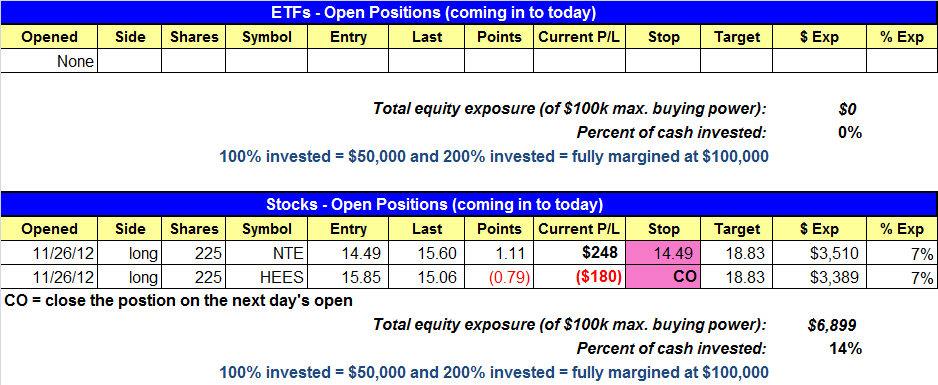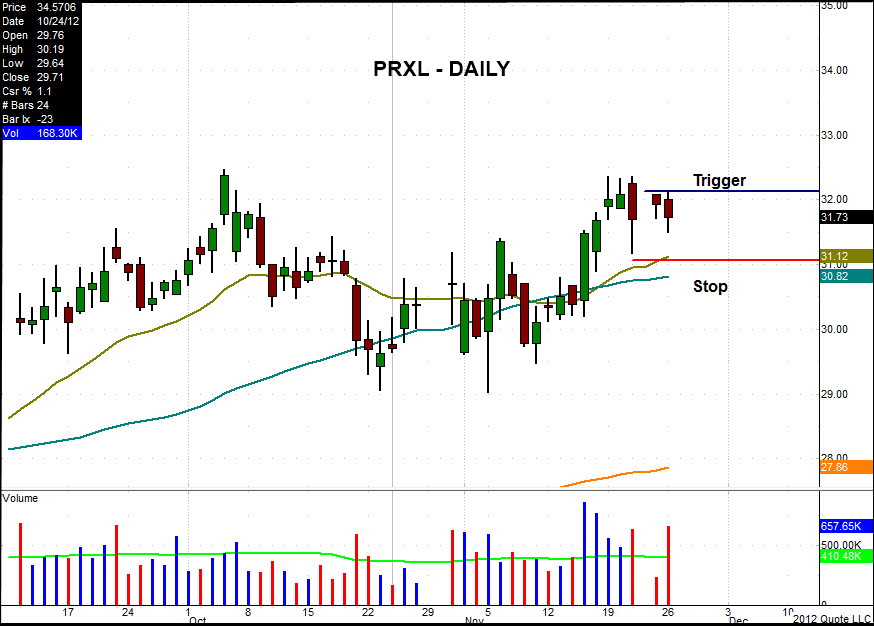market timing model:
Buy – Signal generated on the close of November 23
(click here for more details)
today’s watchlist (potential trade entries):

Having trouble seeing the open positions graphic above? Click here to view it directly on your web browser instead.
open positions:
Below is an overview of all open positions, as well as a report on all positions that were closed only since the previous day’s newsletter. Net P/L figures are based on two separate $50,000 model portfolios (one for ETFs and one for stocks). Changes to open positions since the previous report are listed in pink shaded cells below. Be sure to read the Wagner Daily subscriber guide for important, automatic rules on trade entries and exits.

Having trouble seeing the open positions graphic above? Click here to view it directly on your web browser instead.
closed positions:

Having trouble seeing the closed positions graphic above?
Click here to view it directly on your web browser instead.
ETF position notes:
- No trades were made.
stock position notes:
- HEES and NTE triggered on the long side.
ETF and broad market commentary:
The stock market followed up last Friday’s bullish “accumulation day” with a relatively calm start to the week yesterday. The major indices opened slightly lower, then drifted in a sideways range throughout the day before closing with mixed results. The S&P 500 ($SPX) dipped 0.2%, but the Nasdaq Composite ($COMPQ) ticked 0.3% higher. A bit of buying pressure in the final 15 minutes of trading enabled all but one of the main stock market indexes to close at their intraday highs. As traders returned from the holiday and got back to work, total volume levels were rose substantially (but remember that last Friday’s session also closed three hours early). Overall, yesterday’s market action was indicative of the type of price consolidation that typically follows a strong “up” day in the market.
In yesterday’s newsletter, we said that the price action of November 23 caused our market timing model to generate a new “buy” signal. However, we were quick to point out that we still need to see new leadership developing an individual stocks, as well as a lack of “distribution days” (higher volume selling) over the next five days. Furthermore, we illustrated that the Nasdaq 100 (as shown with the chart of $QQQ) is now approaching major overhead resistance levels that may be difficult to overcome without first having a significant shakeout to the downside.
Overall, this means we have a market that is trying to form a significant bottom, but still needs to prove itself before we would aggressively enter new positions on the long side of the market. As such, it is still okay to selectively look for new short positions as the market rallies into resistance, while simultaneously keeping an eye out for strong ETFs that have low risk patterns for swing trading buy entry. As written in the 5 Modes Of Our Market Timing System under the buy mode, we “may still have 1-2 short positions in the portfolio if the buy signal is weak and the prior decline was significant.”
Going into today, we are “officially” stalking ProShares UltraShort Real Estate Index ETF ($SRS), an inversely correlated “short ETF,” for potential buy entry. As you may recall, we bought and sold this ETF earlier in the month, in locked in a nice profit by selling into strength near its mid-November high. Thereafter, we said we would continue monitoring SRS for a low-risk reentry point on a pullback. As annotated on the daily chart below, we will buy SRS if it moves back above yesterday’s high (trigger price):
Notice that yesterday’s low in SRS corresponded with support of its multi-month uptrend line from the September low, which is also converging with key intermediate-term support of the 50 day moving average. Additionally, SRS “undercut” a major level of horizontal price support, which is bullish because it absorbs overhead supply by shaking out the “weak hands.”
If SRS moves back above yesterday’s (November 26) high, it will be back above major horizontal price support, which would also put it back above support of its 20-day exponential moving average. Even better is that we have a low-risk entry point because a protective stop can now be neatly placed below yesterday’s low (plus some “wiggle room”). This means we would only stop out of SRS if it breaks below both its multi-month uptrend line and 50-day MA, which is a valid place to cut the loss.
Since we’re viewing SRS as a short-term, momentum-based swing trade, our initial price target is just a retest of the mid-November highs, which gives us better than a 2 to 1 reward to risk ratio (minimum requirement for all new swing trade setups). Of course, if SRS triggers for buy entry and starts to move higher, but suddenly reverses back down due to further strength in the broad market, we would still seek to exit and lock in any gains or simply break even on the trade.
In addition to $SRS being added to today’s ETF Watchlist as an “official” entry, notice that we have also added ProShares UltraShort Basic Materials ETF ($SMN). Similar to SRS, we sold $SMN into strength earlier this month for a 9.2% gain on the trade, and have been patiently waiting for a low-risk re-entry point. It’s now a similar setup to SRS, with our trigger for buy entry above the two-day high (which puts it back above the 20-day EMA as well). As always, remember it is crucial to wait for the ETF to actually trade through our exact, preset trigger prices before buying because “jumping the gun” with technical swing trade setups is dangerous to your financial health. If neither SRS nor SMN trigger for buy entry, there is no harm done, and it will be a sign of continuing improvement in the broad market’s health.
stock commentary:
For a buy setup to be cancelled it must open more than 1.3% above the trigger price. Since HEES officially opened at 15.33, the trade did officially trigger, however, we sent an alert stating that the trade was cancelled because the “real open” was somwhere closer to 15.70. Hopefully some of you were able to act on the alert and cancel the trade or sell early in the morning. For those who are still holding HEES, to be fair we are long HEES in the model portfolio from 15.85, and plan on selling the position at market on Tuesday’s open. A buy stop limit order can be used to prevent a higher than expected fill. The buy stop is placed at the trigger price and the protective limit order can be 1.3% above the trigger. However, you must cancel the trade at some point, because if the price action does pull back to the buy stop level the trade will trigger.
NTE triggered early and ripped higher. We have a break-even stop in place. We have one new buy setup today in PRXL:
 –>
–>
If you are a new subscriber, please e-mail [email protected] with any questions regarding our trading strategy, money management, or how to make the most out of this report.
relative strength combo watchlist:
Our Relative Strength Combo Watchlist makes it easy for subscribers to import data into their own scanning software, such as Tradestation, Interactive Brokers, and TC2000. This list is comprised of the strongest stocks (technically and fundamentally) in the market over the past six to 12 months. The scan is updated every Sunday, and this week’s RS Combo Watchlist can be downloaded by logging in to the Members Area of our web site.